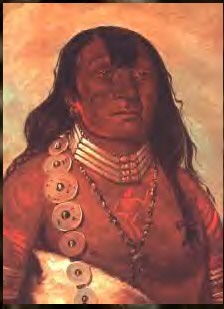
Dohosan ( Little Bluff)
( Tribe : Kiowa )
( Painting by GEORGE CATLIN )
c.1805-1866. Noted for his courage and defiance in the face of threats
from the U.S. government, Dohosan is considered by many to be the greatest
of a hereditary line of chiefs of the Kiowas. In 1833, he became principal
chief of all Kiowas after the Osages decimated a band of Kiowas and took
their Sun Dance gods. As a result, his predecessor, Dohate or "Bluff", was
deposed. Although he signed several treaties (notably the Fort Atkinson Treaty
of July 27, 1852, and the Little Arkansas River Treaty of October 18, 1865),
Dohosan had little regard for the white man and his agreements. He believed
that Indians should fight to retain their lands and rights as free people.
However, he identified with and respected the Mexicans, who thought and fought
much as he died. When Kid Carson started with more than 300 soldiers a winter
campaign against the restive nation of the Kiowas on November 24, 1864, Kid
Carson attacked a camp of Kiowas at Adobe Walls at the Canadien River. Dohosan,
who was only a visitor in this camp, succeded in repulse this attack with
great bravery. When Dohosan died in 1866 at the hands of a Dakota man, his
name was bestowed upon his son, also a distinguished warrior.
The Kiowa - Apache are also known as the Prairie Apache. The name
Apache was applied to them many years ago, because they were thought to be
the same as the Apache people of Arizona. They have not had a connection
with the Arizona Apache, other than belonging to the same language group.
They came from the north, as a part of the Kiowa. Recent authorities now
think the Apache divided somewhere in Montana, one group migrating down the
west side of the Rockies into the Southwest, and a smaller group staying
with the Kiowa. Whichever theory is correct, The Kiowa - Apache have a distinct
language, and call themselves Nadi-ish-dena. The Pawnee and early French
explorers and settlers called them Ga ta'ka, which is the name they appear
as in their first treaty with the United States.
The Kiowa - Apache were associated with the Kiowa before they left the Rocky
Mountains. In 1682, La Salle referred to them as "Gattacka, saying they had
horses, which they sold to the Pawnee. La Harpe in 1719, after being in the
now Oklahoma area, mentioned the tribe as "Quataquios" living on the Arkansas
River as neighbors of the Tawakoni. Lewis and Clark found them in 1805 in
the Black Hills where the Kiowa were.
In 1837, the Kiowa - Apache signed their first treaty with the United States
at Fort Gibson. Since then they have identified with the Kiowa, and for the
most part, share a common history.
In 1865, at their request, the Kiowa-Apache were officialy attached to the
Cheyenne as a result of the Treaty of the Little Arkansas, but in the
Medicine Lodge
Treaty, two years later, were reunited with the Kiowa.
Their principal chief, Pacer, was friendly with the white people and used
his influence to promote peace among the tribes on the Kiowa - Comanche
Reservation until his death in 1875. That year, A. J. Standing, a Quaker,
schoolteacher, had established the first school among the Kiowa - Apache
at their request.
The group had settled peaceably on the reservation and were highly commended
by the authorities for their industry and their efforts to make their own
living. In 1894, Apache John (Gonkon, "Stays in tipi") a concientious leader,
represented them in the delegation to Washington with A'piatan, in protesting
the agreement of 1892. Most of the Kiowa -Apache were living in the vicinity
of present day Apache, in Caddo County, OK, under the leadership of their
chief, Tsayaditl-ti ("White Man"), just before allotments and the opening
of the reservation lands in 1901.
The present location of the Kiowa - Apache is the vicinity of Fort Cobb and
Apache in Caddo County. There are approximately 400 now. Official reports
list their numbers as about 300, when Lewis and Clark found them, 378 in
1871, 344 in 1875, 349 in 1889, 208 in 1896, and only 194 in 1924.
The above information is contained in the book, "A Guide to the Indian
Tribes of Oklahoma" by Muriel H. Wright, published by University of Oklahoma
Press, 1971.
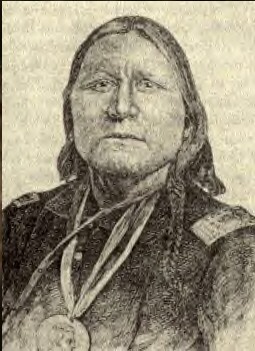
Satanta (Set-Tainte)
1830-1878. Born on the Northern Plains, Satanta ("White Bear Person")
was the son of Red Tepee, who was the keeper of the Tai-me, the Kiowa medicine
bundles. During his boyhood, he was known as Guaton-bain or "Big Ribs". He
was a young man when a prominent warrior, Black Horse, presented him with
a war shiled that he used while raiding in Texas and Mexico. During the early
days of the Civil War, he conducted many raids along the Santa Fe Trail.
He would later become a principal chief in the Kiowa Wars of the 1860s-1870s
and was known as "The Orator of the Plains." When Little Mountain died in
1866, Satanta became the leader of the war faction of the Kiowas. His rival
was KICKING BIRD of the peace faction. As a result of his rivalry, Lone Wolf
became the compromise choice for the position of principal chief. Meanwhile,
Satanta and his warriors continued raiding in Texas. Famed for his eloquence,
Satanta spoke at the Medicine Lodge Treaty of 1867 where the Kiowas ceded
their lands in the valleys of the Canadian and Arkansas Rivers and agreed
to settle on a reservation within Indian Territory. However, some of the
Kiowas were slow to move onto their lands in Indian Territory. When Satanta
came under a flag of truce to tell the U.S. Army that he had not been with
Black Kettle at the Battle of the Washita, General Philip H. Sheridan held
him and several other leaders as hostages until their bands had relocated
to Indian Terretory. In May 1871, Satanta was in a war party that attacked
the Warren wagon train with SATANK, BIG TREE and MAMANTI. Later, Big Tree,
Satank, and Satanta were seized for trial after bragging openly about their
exploits. Satank tried to escape on the road to Texas; he was fatally shot.
Big Tree and Satanta went to trial and were sentenced to death. Indian rights
groups objected to the harsh penalties, however. The Bureau of Indian Affairs
even contended that they should be released because their actions were associated
with war and not murder. In 1873, they were paroled on a pledge of good behavior
for themselves and the entire Kiowa tribe. However, Kiowa, Comanche, Cheyenne,
and Arapaho war parties renewed their raids on white settlers under the Comanche
leader Quanah Parker. These actions started the Red River War of 1874-1875.
Satanta tried to prove to army officials that he was not a party to the raids.
In September 1874, Big Tree appeared to THE Cheyenne Agency at Darlington
to state that Satanta wished to surrender peacefully. True to his word, Satanta
surrendered the next month. Although it appears that he had not violated
the terms of his parole, Satanta was taken into custody and then imprisoned
at Huntsville, Texas. On October 11, 1878, sick, tired, and despairing that
he would ever be released, Satanta jumped off the upper floor of the prison
hospital and committed suicide. The proud and dignified warrior was buried
in Texas. His grandson, James Auchiah, received permission in 1963 to bring
Satanta's remains to Fort Sill, Oklahoma, so that he could be interred with
other Kiowa chiefs.
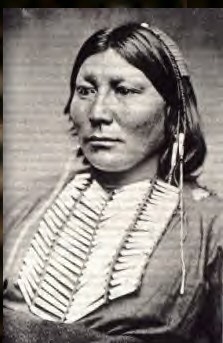
WHITE HORSE
(?-1892). White Horse (Tsen-tainte), a Kiowa chief during the second
half of the nineteenth century, was noted among the tribe for his daring.
Even in his teens he showed remarkable adeptness as an apprentice warrior.
Due to his unusual strength, he became an outstanding horseman, able to snatch
up a child while at a gallop. In the summer of 1867 White Horse joined a
large party of Comanches and Kiowas on a revenge raid against the Navajos,
who were then living in exile on the reservation near Fort Sumner, New Mexico.
On the Canadian River near the Texas-New Mexico line, White Horse and some
of his followers killed and scalped a Navajo warrior. Shortly afterward,
the war party attacked a Navajo village on the Pecos River. Although White
Horse participated in the council at Medicine Lodge Creek in Kansas, he soon
cast his lot with the war faction and gained considerable notoriety during
the early 1870s for his raids on Texas settlements. He and his followers
made a raid on Fort Sill on June 12, 1870, following the annual tribal Sun
Dance, and stole seventy-three mules from the post quartermaster. On June
22 they attacked a party of cattle drovers on the trail a few miles south
of the fort. White Horse killed and scalped two men before a detachment of
troops came to the Texans' relief. Whites considered him the "most dangerous
man" among the Kiowas. Shortly thereafter, White Horse led his band into
Texas, killed Gottlieb Koozer, and took his wife and six children captive.
Subsequently, on August 7 the Quaker Indian agent, Lawrie Tatum, reprimanded
the guilty party and withheld the weekly rations until all captives and stolen
stock were returned; the Koozers were ransomed for $100 each, and raids in
the vicinity of Fort Sill were curtailed, but White Horse defiantly continued
his attacks south of the Red River. On September 30 he ambushed a stagecoach
en route to Fort Concho near Mount Margaret (also known as the Mound) and
killed Martin Wurmser, a trooper who was serving as an escort. White Horse
also participated in the Warren Wagontrain Raid on May 18, 1871, and helped
carry the fatally wounded brave, Hau-tau, to safety during the fight; afterward
he escaped arrest. While the imprisonment of chiefs Satanta and Big Tree
momentarily curbed his raiding, he and Big Bow engineered another attack
on a wagon train in what is now Crockett County on April 20, 1872, which
resulted in the death of seventeen Mexican teamsters. On the way back from
that foray, White Horse was wounded in the arm during a skirmish with Capt.
N. Cooney's Ninth Cavalry troops. On May 19 White Horse's younger brother,
Kim-pai-te, was killed in a fight with L. H. Luckett's surveying crew near
Round Timbers, twenty-five miles south of Fort Belknap. That event prompted
White Horse to organize a revenge raid, and on June 9, with the help of Big
Bow, he attacked the homestead of Abel Lee on the Clear Fork of the Brazos,
about sixteen miles from Fort Griffin. Lee and his fourteen-year-old daughter
Frances were fatally shot, his wife scalped and murdered, and the remaining
three children carried into captivity. Soldiers trailed them, but the Kiowas
escaped back to the reservation and held a scalp dance that went on for several
nights. The Lee children remained captives for a few months before they were
ransomed. After the 1872 councils and the release of Satanta and Big Tree
from prison on parole, White Horse was peaceful for a time but remained with
the war faction. He accompanied the intertribal war party to the second battle
of Adobe Walls in June 1874 and was encamped in Palo Duro Canyon when Col.
Ranald S. Mackenzie's troops attacked on September 27. As a result, White
Horse and his followers surrendered at Fort Sill on April 19, 1875. Because
of the atrocities he had committed, he was among those singled out by Kicking
Bird for incarceration at St. Augustine, Florida. In 1878 he was returned
with the others to the reservation near Fort Sill, where he spent his remaining
years peacefully with his family. White Horse died of a stomach ailment in
1892 and was buried on the reservation.
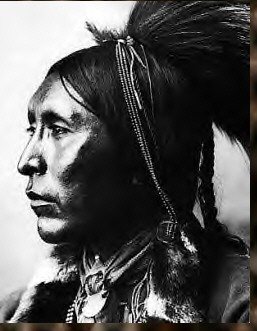
TWO HATCHET
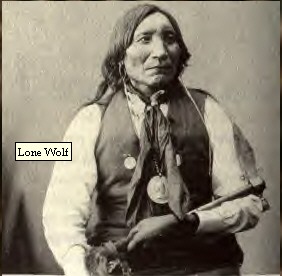
Lone Wolf ( Guipago )
Kiowa Chief . c.1820-1879

KICKING BIRD
1835-1875





